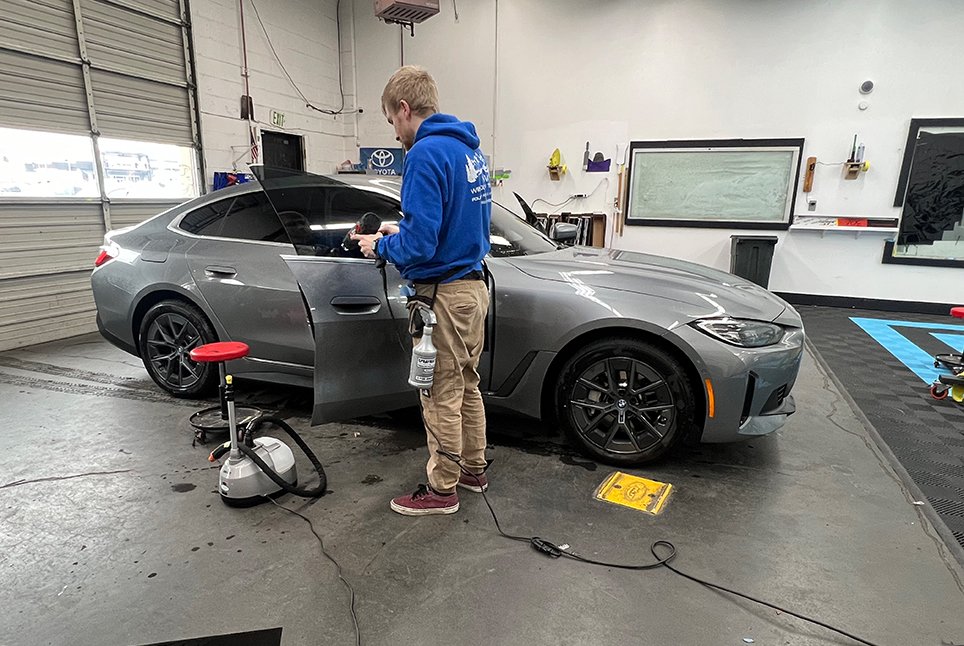Vehicle Window Tinting: Improve Comfort and Minimize Glow While Driving
Vehicle Window Tinting: Improve Comfort and Minimize Glow While Driving
Blog Article
Window Tinting Rules and Guidelines: What You Need to Know Before Tinting Your Vehicle
Before continuing with window tinting for your lorry, it is crucial to acquaint yourself with the varied regulations and standards that regulate this method across different states. These laws determine the allowable levels of tint darkness, commonly gauged by noticeable light transmission (VLT) portions, and consist of certain terms for front windscreens intended at guaranteeing road safety and security.
Introduction of Home Window Tinting Laws
Window tinting laws are frequently based on variant across various territories, showing regional guidelines and security considerations. These regulations determine the permissible levels of tint darkness and reflectiveness on car windows, making sure that vehicle drivers maintain ample visibility while also protecting against unsafe UV rays and warm.
A lot of laws classify home window tinting based upon the Visible Light Transmission (VLT) portion, which shows the amount of light that can go through the home window. Normally, reduced VLT portions symbolize darker tints. Legislations frequently differentiate in between the front, side, and back home windows, with stricter restrictions related to the front windshield to boost safety for both the vehicle driver and various other road individuals.
Compliance with window tinting laws is critical, as violations can result in fines, obligatory elimination of the tint, and prospective boosts in insurance policy costs. It is essential for car owners to familiarize themselves with local laws prior to continuing with home window tinting installations.
State-by-State Tint Regulations
Recognizing the details window tinting policies in each state is essential for vehicle owners seeking to follow the law. Each state in the united state has actually developed its own collection of guidelines controling window tinting, which can vary dramatically. These policies commonly dictate the allowable levels of tint darkness, the sorts of windows that can be tinted, and any kind of clinical exemptions that may apply.
As an example, states like California have strict restrictions on color darkness for front windows, while others, such as New Mexico, might enable darker tints. Furthermore, particular states mandate particular exposure percents for different windows, including the windshield, front side windows, and rear windows. It is critical for vehicle proprietors to acquaint themselves with their state's regulations to avoid possible fines or penalties.
Moreover, some states may need a certification sticker to be positioned on tinted home windows, suggesting conformity with state laws. Failing to comply with these regulations not just runs the risk of legal repercussions however can also affect safety and security and visibility while driving. For that reason, car proprietors ought to perform extensive research or get in touch with local authorities to guarantee full understanding and conformity with state-by-state tint laws.
Allowed Tint Levels and Kinds
Many lorry owners may be amazed to discover that enabled color levels and kinds differ widely across different states. Each state has established its own guidelines regarding the permitted darkness and reflectivity of home window tint, usually gauged by Visible Light Transmission (VLT) percentages. VLT describes the amount of light that can pass through the colored windows; therefore, a lower percentage indicates a darker tint.

Furthermore, the sorts of tint materials allowed can vary, with some states banning mirror-like or metallic finishes. It is necessary for lorry proprietors to acquaint themselves with their state's specific regulations to ensure compliance. Non-compliance can cause penalties, obligatory removal of the tint, or other lawful consequences, making it critical to recognize these laws prior to continuing with installation.
Medical Exemptions for Tinting
While not all states offer allowances for clinical exemptions pertaining to home window tinting, those that do recognize the necessity for specific people to boost presence and comfort due to medical problems. Various medical conditions, such as lupus, skin cancer cells, and certain eye problems, can make individuals particularly delicate to sunlight. These people may require darker colors to shield themselves from unsafe UV rays and glow.

It is important to keep in mind that despite a medical exception, there may still be constraints on the level of tint allowed. Compliance with state laws makes sure that individuals are both safeguarded and within legal limitations. Those taking into consideration medical exemptions must call their regional Department of Electric motor Automobiles or comparable authority to understand the requirements and treatments required to request an exception successfully.
Charges for Non-Compliance
Failing to adhere to home window tinting legislations can cause considerable penalties, which differ by state. Law enforcement agencies are equipped to provide citations for automobiles that do not adhere to the specified tinting guidelines. These fines generally include penalties, which can range from modest total up to several hundred dollars, depending upon the extent of the offense and the state concerned.
In some territories, duplicated offenses might cause intensifying penalties or additional penalties, such as necessary court looks. Non-compliance might demand the removal of unlawful tinting, typically at the owner's expenditure. In extreme situations, regular culprits may encounter suspension of their lorry registration until compliance is achieved.
Additionally, insurance implications may develop from receiving several citations for window color offenses. Insurance firms might see such infractions as an indication of riskier behavior, possibly causing increased why not find out more costs or trouble in coverage.
To stay clear of these fines, it is vital for automobile owners to acquaint themselves with their neighborhood home window tinting laws and make certain that their automobile complies (Window Tinting). This positive approach not just prevents legal implications however likewise advertises road safety
Conclusion

A lot of guidelines categorize window tinting based on the Visible Light Transmission (VLT) percent, which indicates the quantity of light that can pass through the window. Compliance with window tinting policies is crucial, as infractions can result in penalties, obligatory removal of the tint, and prospective rises in insurance coverage costs.Understanding the certain home window tinting regulations in each state is vital for lorry these details proprietors seeking to conform with the law. These policies often determine the permitted levels of tint darkness, the kinds of home windows that can be tinted, and any type of medical exemptions that may apply.
For instance, states like The golden state have rigorous restrictions on color darkness for front windows, while others, such as New Mexico, might enable darker colors.
Report this page